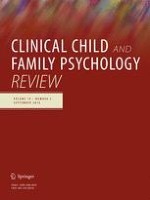08-07-2016
Distilling Common History and Practice Elements to Inform Dissemination: Hanf-Model BPT Programs as an Example
Gepubliceerd in: Clinical Child and Family Psychology Review | Uitgave 3/2016
Log in om toegang te krijgenAbstract
There is a shift in evidence-based practice toward an understanding of the treatment elements that characterize empirically supported interventions in general and the core components of specific approaches in particular. The evidence base for behavioral parent training (BPT) and the standard of care for early-onset disruptive behavior disorders (oppositional defiant disorder and conduct disorder), which frequently co-occur with attention deficit hyperactivity disorder, are well established, yet an ahistorical, program-specific lens tells little regarding how leaders, University of Oregon Medical School, shaped the common practice elements of contemporary evidence-based BPT. Accordingly, this review summarizes the formative work of Hanf, as well as the core elements, evolution, and extensions of her work, represented in Community Parent Education (COPE; (Cunningham et al. in J Child Psychol Psychiatry 36:1141–1159, 1995; Cunningham et al. in COPE, the community parent education program: large group community-based workshops for parents of 3- to 18-year-olds, COPE Works, Hamilton, 2009), Defiant Children (DC; (Barkley in Defiant children: a clinician’s manual for assessment and parent training, Guilford Press, New York, 1987; Barkley in Defiant children: a clinician’s manual for assessment and parent training, Guilford Press, New York, 2013), Helping the Noncompliant Child (HNC; Forehand and McMahon in Helping the noncompliant child: a clinician’s guide to parent training, Guilford Press, New York, 1981; McMahon and Forehand in Helping the noncompliant child: family-based treatment for oppositional behavior, 2nd ed., Guilford Press, New York, 2003), Parent‐child interaction therapy (PCIT; Eyberg and Robinson in J Clin Child Adolesc Psychol 11:130–137, 1982. doi:10.1080/15374418209533076; Eyberg in Child Fam Behav Ther 10:33–46, 1988; Eyberg and Funderburk in Parent–child interaction therapy protocol, PCIT International, Gainesville, 2011), and the Incredible Years (IY; (Webster-Stratton in Behav Ther 12:634–642, 1981. doi:10.1016/S0005-7894(81)80135-9; Webster-Stratton in J Pediatr Psychol 7:279–294, 1982. doi:10.1093/jpepsy/7.3.279; Webster-Stratton in The incredible years: parents and children series. Leader’s guide: preschool version of BASIC (ages 3–6 years, The Incredible Years, Seattle, 2008). Our goal is not to provide an exhaustive review of the evidence base for the Hanf-Model programs, rather our intention is to provide a template of sorts from which agencies and clinicians can make informed choices about how and why they are using one program versus another, as well as how to make inform flexible use one program or combination of practice elements across programs, to best meet the needs of child clients and their families. Clinical implications and directions for future work are discussed.
